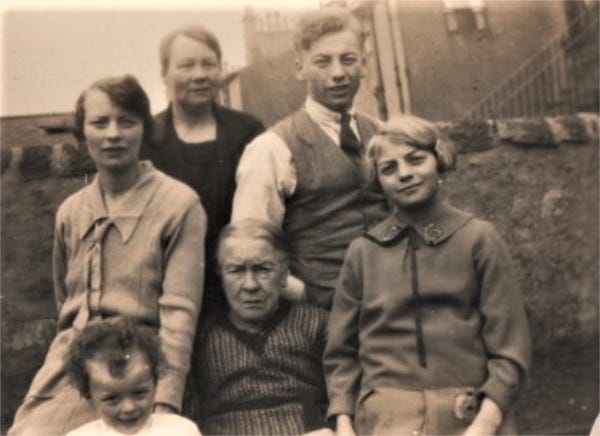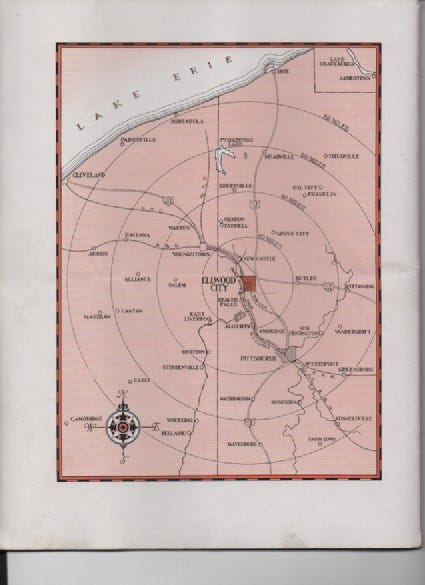Douglas Thomson (1897-1982) and Joan Beck (1900-1969)
The Return: SS Transylvania, Firth of Clyde, 27 June 1932
“One hour. One hour and passengers must assemble at the designated assembly points for disembarkation.” That was the message on the tannoys.
Joan Thomson looked at the Mull of Kintyre over the side of the SS Transylvania. Homeward bound for Glasgow from New York. Her husband supervised the last game of deck quoits for Sheila and the friends she had made on the voyage. She had a little time to reflect on the past few years in Ellwood City, Pennsylvania.
So, back to square one. Back to Scotland after four years. It might have worked, but it didn’t. No one was to blame. Just what the newspapers called ‘The Great Depression’. People out of work in their millions across the world. The dream of a better life in America is gone with redundancy. A house sold, friends left, and a plan evaporated. However, there were positives. Home to stay with a widowed mother. It’s time to look after Doug’s mother as well. A return to people and places which she knew well. Fitting like an old glove. But could Doug find work? At least he was a citizen, which was more than he had been in the United States. It would not be easy. Had they done the right thing?
These thoughts filtered through her mind as she saw the lighthouse appear. The ship began to tilt gently to its left or port side. It was entering the Firth of Clyde.
The Steps Leading to Emigration: Why Leave Your Own Country?
It was back in 1925 that the rumours had started about a possible closure of Rosyth Naval Dockyard. They had been married for eighteen months with a baby daughter. Douglas was an engine fitter in the yard, and they had moved from Kirkcaldy to Rosyth after their wedding in December 1923.
They rented a new two-bedroom flat in the garden city of Rosyth. An excellent place to live with its wide pavements and tree-lined streets, It was full of tradespeople who had come from all over the country to work there and service the Grand Fleet along with families from Plymouth, Portsmouth, Chatham and Pembroke. Her daughter, Sheila Sutherland Thomson, was born in King’s Crescent in September 1924.
Joan remembered the conversations with her husband and her father, John Beck. Both were engine fitters in the dockyard. John had been there since the manically busy days of the First World War when Rosyth was the fleet base of Admiral Beatty’s Battle Cruiser squadron. It was he who had got her husband Douglas the job in the yard before their marriage. A safe and secure job they had all thought. However, it wasn’t.
With Britain struggling to stay on the Gold Standard and the signature of naval treaties to reduce the size of fleets, the rumours of government cutbacks grew ever more vital. Douglas began to discuss emigration with his older brother Jimmy, who was an electrician.
Perhaps emigration to the USA where their uncle, Daniel B Jerman, formerly of Lampeter in Wales, was making a fortune from a chain of stores in Oregon and Washington? He had sold these and became the regional manager for Sears Roebuck and their mail order business in the Pacific Northwest of the United States. He was living just outside Portland, Oregon. Then the axe fell.
Pembroke Dockyard was closed, and Rosyth was put on a ‘care and maintenance’ basis. It was mothballed. Her father clung on and was one of the last engine fitters to be transferred in February 1926, when Joan’s parents were moved to Portsmouth. Douglas returned to work in Kirkcaldy as a maintenance engineer in a linoleum factory.
Then Douglas and Jimmy decided that it was time for America. They would send for their families when they got established. Doug sailed for America on his own in April 1927 on the Steamship ‘Leviathan’, and his older brother Jimmy followed on the same ship in August. The call came, and in August 1928, Joan was on the way across the Atlantic with Sheila, her sister-in-law Jessie and her two young sons, Norman and Ian. Once again, the ship was the ‘Leviathan’ on the Southampton-Glasgow-New York run.
It was hard, very hard for Joan to leave Scotland, especially as her father had suddenly died in August 1926 in Portsmouth, leaving her mother widowed, with brother Bill only nineteen and sister Elsie not yet ten... Also, Douglas had met an American on the voyage out to New York and been offered an engineering job in a little town outside Pittsburgh. They weren’t going to Oregon like Jimmy and Jessie. They were headed for Ellwood City, Pennsylvania. They were on their own.
Small Town America: Ellwood City, Pennsylvania
Ellwood was everything that they hoped it might be. Suitable housing to rent and the prospect of buying one of the lovely houses springing up around the commercial district of Ellwood City. A loan would be forthcoming from the Ellwood City Building and Loan Association to buy the property at 525 Sixth Street. All were financed by Doug’s job as an engine fitter with the Aetna Standard Engineering Company, who manufactured heavy machinery for the steel industry.
The town was booming and set to reach 14,000 inhabitants. It was self-contained in every way with schools, a hospital, five churches, including a Presbyterian one, and a handsome Country Club and golf course. Set in rolling, wooded, gentle hills, there was plenty of scenic countryside. Friends were easily made, and they had some lovely parties, bathing trips and picnics. Joan sighed. It had been hard to leave the Manning family and their other American friends.
The Great Depression
At first, the problems of the Wall Street crash were felt elsewhere, and life in Ellwood continued much as before. But then, the major manufacturing companies were not getting orders for the first time in a generation. Even Aetna-Standard stopped recruiting. Then businesses began to close, and many others began to lay off their workforce. Eventually, it was Doug’s turn to be made redundant. Out of work. Not a US citizen. Millions of Americans were idle, and the prospects looked bleak. After nine months of scraping along, it was time to go home. Back to Scotland, back to Dunfermline.
Virtually all her new furniture was sold along with the house. Only an American radio cabinet, which was in the ship’s hold, along with her carefully packed wedding china, which was a Royal Albert white and gold tea service and a finely detailed Noritake coffee set, made the journey back to Europe.
She had been tossed by economic reality from one side of the Atlantic and back again. At least she would see her mother again that day when they returned to Dunfermline. That was something.
Notes
1. Joan Stuart Hastie Beck married Douglas Jerman Thomson on 28 December 1923 in Rosyth in a Church of Scotland wedding. They both were residents in Kirkcaldy, which signalled the start of their new life in Scotland’s only garden city, Rosyth, where Douglas was employed as an engine fitter. Sheila Sutherland Thomson was born to them on 17 September 1924. By all accounts, it was a difficult birth. Joan almost died, and it left Douglas extremely upset by the experience. They had no more children.
2. Joan’s father, John Pettigrew Beck, an engine fitter, had moved to work in Rosyth Naval Dockyard on 7 March 1916 after a year working in Portsmouth Naval Dockyard. John’s sister Janet Beck had married a prosperous shopkeeper, Tom Ryall, in Ryde on the Isle of Wight. John and his father, William, a ship’s painter, had taken contracts on the island or in Portsmouth Dockyard when work was hard to obtain in Scotland. The Rosyth Dockyard employee book for John Beck still exists. His pay as an engine fitter increased from thirty-nine to forty-seven shillings per week between 1915 and 1926, when he was transferred back to Portsmouth Naval Dockyard on 20 February 1926.
3. Ellwood City is mainly in Lawrence County, Pennsylvania. It grew from virtually nothing in the late 19th century due to heavy industry, quarrying and coal mining. It ceased to grow around 1930 and has been constantly shrinking since 1950 to such a point that the current population is just over 7,000, just over half of what it once was. It is 98% ethnic white. 525 Sixth Street still stands and is a pleasant brick and timber building now partly a podiatrist’s office. The main streets in the 1930s looked remarkably like Bedford Falls in the film, ‘It’s a Wonderful Life’. Ellwood City is just over thirty miles from Pittsburgh.
4. The radio cabinet became a drinks cabinet when back in Scotland. It supported Doug and Joan’s television set in the 1950’s. It still holds glasses and bottles of spirits. The china survived the journey and is still in the family. There is also an Art Nouveau small bronze statue of a nubile discus thrower, which was made in America. Doug’s metal deed box contained a brochure for new arrivals in Ellwood and a slightly later town map. There are plenty of photographs of the family in and around Ellwood, including the swimming parties and picnics.
BY DONALD ADAMSON





